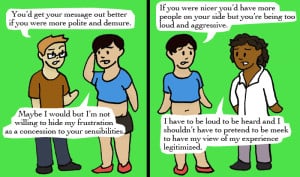
One person sits facing another with a pained “are you kidding?” smile. Source: Network Nuts
Occasionally, sexism presents as overtly as a billboard that reads “You Are Not Welcome Here.”
Much more frequently, however, sexism has an additionally subtle way of excluding people. Microaggressions are an example of these indirect forms of discrimination that make individuals feel unwelcome based on aspects of their identity.
Catcalling and street harassment, unwanted sexual touch, and gendered spaces are all examples of sexist microaggressions. They are reflected in the things we say, the things we do, and the way we situate our environments.
They exist on structural levels and personal levels, and they are a part of people’s everyday experiences.
The hard thing about microaggressions is that, in many cases, they are entrenched in our culture and society. That means they sneak into our minds and out our mouths without us being completely aware.
That also means that anyone — from your fellow activist to your kind aunt — is capable of engaging in microaggressions.
A few years ago, I got into a heated argument with a partner about privilege. At one point, they said, “Women can just have sex with their boss to get a promotion. That’s privilege.”
I remember feeling shocked that someone I was close to could not only understand how that very assumption was damaging to women in the workplace, but how that assumption was damaging to me.
When faced with microaggressions, it can be difficult to know what to do or say, let alone when it comes from someone you love and care about. Although a heated argument is one way to respond, it is definitely not the one I would recommend.
Here are some other suggestions for what you can do when a sexist microaggression sneaks into your conversation.
1. Present Another Way of Viewing the Situation
Confrontation does not always mean saying “You’re wrong.” A more subtle form of confrontation can be saying “That’s not always right.”
When a sexist microaggression sneaks into your everyday conversation, a gentle redirection regarding why a given statement is not altogether true or factual can be helpful.
I was chatting with a group of friends the other day when one of them expressed their surprise to hear that I never wanted children.
“I feel like it’s human nature to want to produce something,” he said. “At the end of your life, you know you made an impact.” The impact he was referring to was a baby.
I could have chosen to respond in a number of ways. For that conversation, however, I felt comfortable presenting another way of conceptualizing “production.”
I calmly talked about other ways in which I could “produce” something, through meaningful work, fostering positive relationships and friendships, and by cultivating a life of meaning for myself.
The concept of “production” as human nature and “reproduction” as the achievement of life satisfaction is laced with capitalistic and patriarchal undertones.
Those bigger conversations do not have to happen right away. Sometimes it feels safer and more productive to shift and open the conversation ever so slightly, making more room for those bigger conversations.
Some examples of how you can start that conversation include:
- I experience that like…
- I’ve heard it explained like…
- That could also mean…
- That could also be experienced through…
2. Challenge the Microaggression
A similar way of approaching microaggressions is by challenging the validity of them. In the same conversation discussed above, I also challenged how accurate the idea of parenthood was in relation to life satisfaction.
It can sometimes be helpful to have facts or statistics on hand, but certainly not necessary. Microaggressions are rarely grounded in reality — they are often a product of hardwired feelings justified through culture and social norms.
A challenge can simply be saying “That’s not my experience, and it’s not the experience of many other people.”
In that conversation, I felt comfortable saying, “For a woman who wants to be a mother, maybe she would be disappointed by not having that chance. But I don’t want to be a mother, so that’s not something I am looking for in my life.”
That was my way of challenging the idea that all women want to be mothers.
Other language you can use to challenge microaggressions includes:
- I’ve heard/experienced the opposite…
- Some people would tell you…
- I’m not sure that reflects my experiences…
- I have felt differently when…
Another good way of challenging microaggessions is to ask questions:
- Where have you heard that?
- Who have you talked to about that?
- Do you think there are other opinions about that?
- How might someone disagree with that?
3. Express Your Disagreement
Sometimes you may feel more comfortable or compelled to simply say, “That’s not right.” I am a firm believer that no further explanation is necessary.
You are a person navigating complicated relationships, dinner dates, happy hours, work, and social environments.
You are probably faced with an endless number of microaggressions — not just sexist ones, but ones that challenge a multitude of your own identities and the identities of people you know and care about.
You are not a full-time educator. You can express your disagreement and simply say, “I am not interested in having this conversation right now, but it’s important for you to know that I am not okay with what you just said.”
You have taken time and effort to do your homework. So can they.
4. Explain to Them Why You Disagree
Having said that, you may want to explain and engage in a dialogue about why something is a sexist microaggression. This can open up opportunities for growth and compassion.
I engage in microaggressions every day, and I am grateful when I am given the opportunity to talk about why what I am doing is harmful and how I can rectify it.
- Messages like that often come from culture and society, and do not always reflect what is actually happening for people.
- I identify as _____, and that has not been my experience. I have experienced…
- I have studied and talked to people who identify as _____, and my understanding is that that is not their experience. They have experienced…
- I have read and learned about that, and what you are saying is not only untrue, but it is also harmful. Comments like that contribute to…
Conversations about why sexist microaggressions are, in fact, sexist, can be exhausting. Keep in mind that you probably will not reverse years of social conditioning in one conversation. (Although if you are able to, share your secrets below!)
You are planting a seed of dissent; over the years, that seed can grow as more information is provided to counteract the sexist messages we receive daily.
Disagreeing with a stranger at a bar can feel safer, in some ways, than disagreeing with a friend or a loved one. Emotions surrounding an already personal topic can feel heightened.
It is important to remember: Good people can (and do) engage in microaggressions. People you love can (and do) engage in microaggressions.
That doesn’t make it hurt any less. It also doesn’t make these conversations any easier. But challenging them can help create more honest communication with those around you.
At the very least, it can help them understand where you’re coming from and establish boundaries around certain topics.
5. Change or Redirect the Conversation
I understand that you may not always feel comfortable directly challenging microaggressions. You may not be in a space where you feel like it would be helpful, either for the person you are confronting or for yourself.
If you hear a sexist microaggression, you always have the option to indirectly confront it by simply changing the topic.
This doesn’t have the same level of satisfaction or impact as intervening, but it can stop a sexist comment from turning into a sexist conversation.
It can also be a subtle sign that you do not agree. Disengagement has always been a form of resistance when other options do not seem feasible.
- Let’s talk about…
- Did you hear that story about…
- What did you think when…
- I’ve always wondered…
You can redirect the conversation based on what was being discussed or present a completely different topic. It might feel awkward at first, but redirection can be effective when you feel like other conversations might simply escalate.
6. Nothing
Just like you are not a full-time educator, you are not required to intervene at every microaggression you hear.
There will be times when you will choose to do nothing. That might depend on the environment you are in, the power differentials in the conversation, your own level of comfort, and your own level of burnout.
That’s okay.
Sometimes you just love your grandmother and want to spend your holiday dinner talking about how to make the perfect mashed potatoes, not arguing about how the pressure to get married is part of a greater oppressive system.
Our ability to challenge every day microaggressions is what helps create a shift in our culture. That shift will happen gradually, in our personal lives and on a grander scale.
However, the weight of it does not fall solely on your shoulders.
Do your part, but also know that we are creating this shift together. Sometimes we will succeed, sometimes we will falter, and always we will continue forward.
What are other ways you have found helpful in responding to sexist microaggressions in every day conversations?
[do_widget id=”text-101″]
Aliya Khan is a Contributing Writer for Everyday Feminism and identifies as a feminist, activist, and life-long learner. She provided crisis support to survivors of abuse at the Women’s Center and Shelter of Greater Pittsburgh and is currently living, studying, and writing in the Pacific Northwest.
Search our 3000+ articles!
Read our articles about:
Our online racial justice training
Used by hundreds of universities, non-profits, and businesses.
Click to learn more




















